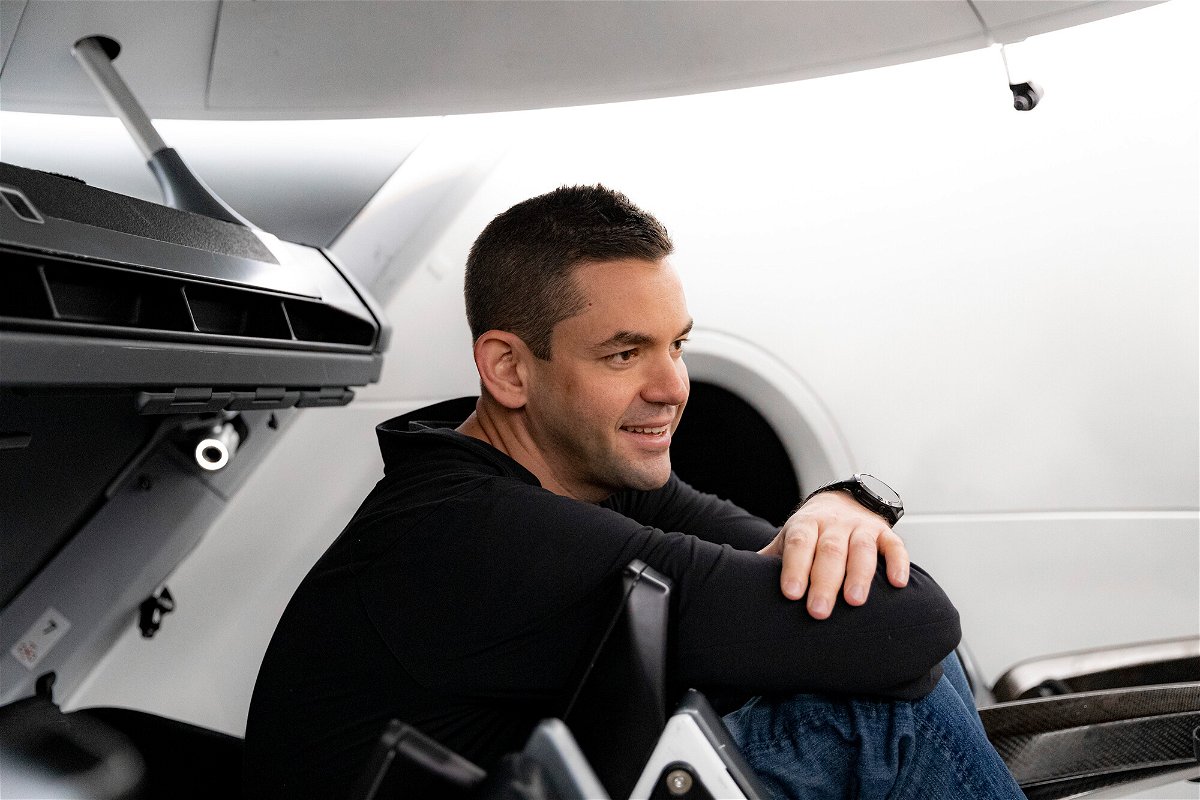A billionaire CEO is on track to go further into space than any human in 50 years

SpaceX sells three more flights to billionaire Jared Isaacman
By Jackie Wattles, CNN Business
Jared Isaacman — the billionaire CEO of payments processing company Shift 4 — is buying three more flights with SpaceX, the first of which is scheduled for this year and could put Isaacman and SpaceX on track to travel deeper into space than any human has traveled in a half century.
The first flight in the series of missions, which are being called “Polaris” after the North Star, is planned for late this year and will last up to five days and include a crew of Isaacman and three other people. It’s expected to travel out to the Van Allen radiation belt, which has an inner band that stretches from about 400 to 6,000 miles above Earth, in part to help the crew research how radiation in space affects the human body. Radiation remains a serious concern for spaceflights to the moon and Mars, as SpaceX says it aims to do, because they would require prolonged exposure to radiation, which can lead to an “increased risk of cancer and degenerative diseases” and other long-term impacts, according to NASA.
When asked on a press call Monday, Isaacman said the Gemini missions of the 20th century, which set altitude records at the time, are a guidepost for how high the first Polaris mission will travel. Gemini missions reached as high as about 850 miles — or about three times higher than where the International Space Station orbits. Isaacman declined to share a specific altitude for the flight.
During that mission, the crew will conduct a space walk, a first for anyone traveling aboard a SpaceX Dragon capsule. Isaacman made the announcement on NBC’s Today Show on Monday morning and in an interview with the Washington Post.
Isaacman, who gained international attention when he purchased the first SpaceX all-tourism flight dubbed “Inspiration 4,” said that the first Dragon mission will be followed by a second Dragon mission shortly thereafter. Those two missions will pave the way for the first-ever crewed mission on SpaceX’s forthcoming Starship rocket, the one Elon Musk hopes will one day ferry people to Mars.
“We’re gonna go farther into space than humans have gone since we last walked on the moon,” he told the Today show.
It’s not clear if all this will go according to plan, nor has SpaceX said whether it will need to complete additional testing before Isaacman can make his trek to deep space. SpaceX also has not addressed what if any updates Crew Dragon will need to complete the mission safely. So far, the spacecraft has carried astronauts only on trips to low-Earth orbit, or the area of space directly surrounding Earth. The Inspiration 4 mission marked the highest Crew Dragon has flown thus far, at at a roughly 360-mile altitude, and Monday’s announcement indicated the first Polaris mission will travel at least twice that far.
It’s not clear how much these missions will cost Isaacman, and he declined to comment on the matter Monday morning. He also did not reveal how much he paid for the Inspiration 4 mission last year, though he said he paid less than $200 million.
“We know space is expensive,” Isaacman said when asked about the costs of the Polaris program during a media call, adding that it’s already “fully funded.”
“Costs will come down just as they have for any other groundbreaking technology,” he said. “This is a contribution from both SpaceX and myself towards the important goals we want to achieve with the Polaris program.”
The Inspiration 4 mission was billed as a St. Jude Children’s Hospital fundraiser, and it fetched a total of $243 million for the organization. Isaacman donated about $100 million, Musk put in another $50 million and the remainder was raised through public donations. The Polaris missions are also expected to support the same cause.
On the first Polaris mission, Isaacman will be joined by veteran Air Force fighter pilot Scott Poteet and two SpaceX operations engineers — Sarah Gillis, and Anna Menon, who will serve as the onboard medical officer. Isaacman will be the only crewmember with prior spaceflight experience.
Apart from his spaceflight ambitions, Isaacman also flies jets recreationally. Most recently, he was seen piloting an Alpha Jet, often used for training pilots, over SpaceX’s Starship facilities in South Texas.
Poteet is a former vice president at Shift 4 who previously spent 20 years in the Air Force. Poteet also served as a flight director on the ground supporting Inspiration 4. He and Isaacman are also frequent flying partners.
Gillis and Menon could be the first SpaceX employees to travel to space.
Details about the space walk that the Polaris crew is planning to conduct on the first flight are light, but a press release states they will use “SpaceX-designed extravehicular activity (EVA) spacesuits, upgraded from the current intravehicular (IVA) suit.” The IVA suit refers to the pressurized black-and-white spacesuits that NASA astronauts and the Inspiration 4 crew have worn aboard Dragon during launch and reentry.
But exiting the spacecraft while it’s in orbit will require a much heavier duty system of protection. NASA has described its EVA suit as “a miniature spaceship shaped like a human body that protects the astronaut from the dangers of being outside a vehicle while in space or on the Moon,” offering protection from “radiation, dust, debris, and extreme temperatures.”
According to to its website, the space walk will be conducted when the Crew Dragon is flying about 300 miles above Earth, or roughly the same altitude as the ISS.
Much of the technical details remain unknown. Crew Dragon does not have an airlock, for example, which would allow a single person to exit the spacecraft in an EVA suit while the remaining crew members stay safely locked inside their airtight, pressurized cabin. Without an airlock, the entire cabin will become depressurized — as it did during spacewalks conducted by NASA astronauts during the Gemini missions.
“For this mission, the suit that we’re going to be designing will be a single suit that we would launch [in] and then similarly use for the EVA,” Gillis said.
“We’ll certainly be doing so safely,” Menon added.
Also on the first Polaris mission, the crew will test out the use of Starlink — SpaceX’s satellite-based internet business — for in-space communications. Thus far, Starlink has only been used to beam internet connectivity to customers on the ground, but the Polaris press release suggests the system could be used to support communications during orbital flights.
During the mission, the crew will also conduct some research related to health, including a study on decompression sickness and another focused on how astronauts might mitigate Spaceflight Associated Neuro-Ocular Syndrome, or SANS, a condition that can alter the structure of the eyes and brain that is brought on by weightlessness and has been reported by up to 70% of astronauts. Symptoms can include loss of near vision, blind spots, headaches and loss of depth perception.
Starship
The schedule for Isaacman’s Starship flight isn’t exactly clear. During a presentation about Starship in Texas last week, Musk said that while he’s hopeful the vehicle — which has so far conducted only brief, suborbital “hop tests” — will make its first orbital flight test this year, without a crew. That, however, could depend on whether federal regulators give SpaceX approval to launch Starship out of South Texas, where the company has already set up an orbital launch pad and the vast majority of Starship resources are located.
That could mean that Isaacman is leap-frogging the first billionaire who purchased a Starship mission — Japanese fashion mogul Yusaku Maezawa. Maezawa paid SpaceX an undisclosed amount of money to secure a seat for himself and a group of artists on a Starship trip around the moon, hoping it could take off as soon as 2023. Maezawa is still in the process of deciding who he’ll take with him.
Musk also said during the presentation that he hopes Starship will cost less than $10 million per flight within a few years, which, if obtainable, would be far cheaper than any other rocket on the market.
Starship is expected to be far more powerful than any rocket humanity has ever built. Musk has said it would boast twice the thrust of the Saturn V rockets that powered the moon landings last century.
The-CNN-Wire
™ & © 2022 Cable News Network, Inc., a WarnerMedia Company. All rights reserved.


